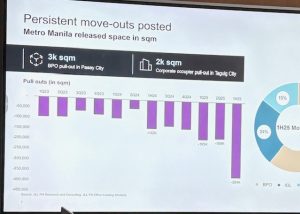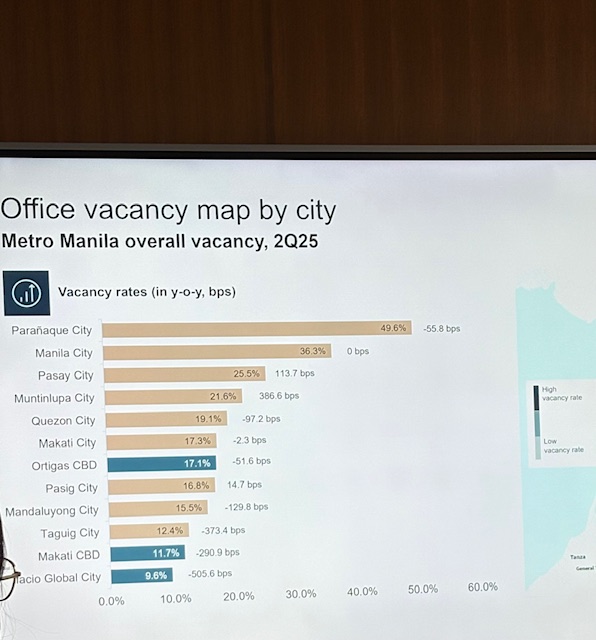Moveouts and elevated vacancy rates are expected to continue in the domestic office and retail space markets as new supply comes online, dampening rental rate increases, according to JLL, one of the country’s leading property management consultancy firms.
Janlo de los Reyes, head of research and strategic consulting at JLL Philippines, shared during the company’s Second Quarter 2025 Market Overview that the total existing office space supply stands at 11.1 million square meters (sqm), with an additional 1.8 million sqm expected to come on-stream from 2025 to 2030. New deals in leasing in Metro Manila are distributed into services and financing services (non-banking) at 23 percent each, followed by logistics at 21 percent, and manufacturing 14 percent.
De los Reyes noted that while gross leasing surged by 80.2 percent to 582,000 sqm in the first half of the year, significant moveouts by office occupiers shaped the market during the same period.
These moveouts involved tenants relocating to other central business districts with cheaper rents or newer facilities. There were 384,000 sqm of office space movements in the first half of 2025, including 189,000 sqm expected in the second half.

Of these movements, the BPO sector accounted for 61 percent, Internet Gaming License (IGL) firms 24 percent, and corporate occupiers 15 percent. For instance, JLL recorded a 3,000 sqm BPO pullout in Pasay City and 2,000 sqm in Taguig.
At the city and district level, Makati City led in moveouts, primarily from older developments.
“As tenants sought leased spaces in newer buildings with more competitive rentals, the leasing market remains quite soft in terms of rental rates, giving occupiers more options to move,” de los Reyes said. He added that the absence of new supply in the past three quarters contributed to a slight decrease in supply in the first half of the year.
However, he cautioned about a large volume of new supply expected soon. “We expect around 516,000 square meters of new stuff by the second half of the year within Metro Manila. So, city and district level, vacancy levels are expected to remain elevated across districts and cities,” he said.
Office vacancy rates reached 18.2 percent in the second quarter, slightly down from 18.4 percent in the first quarter.
Bay Area
The Bay Area—comprising Parañaque City, Manila City, and Pasay City—continued to experience high vacancy rates due to vacant spaces left by Internet Gaming Licensees and weak demand from both BPOs and corporate occupiers.
JLL data showed Parañaque had the highest vacancy rate at 49.6 percent in the second half of the year, followed by Manila City at 36.3 percent, Pasay City at 25.5 percent, and Muntinlupa at 21.6 percent. Quezon City recorded a vacancy rate of 19.1 percent.
The lowest office vacancy rates were in Bonifacio Global City at 9.6 percent and Makati CBD at 11.7 percent. Rental rates also remained soft to flat.
Meanwhile, the rental market stayed relatively flat in the second quarter. Rents averaged around ₱970 per square meter per month, buoyed by the lack of new supply over the past three quarters.
De los Reyes said rental rates are expected to remain soft by year-end, especially with the downward pressure from incoming stock. He noted that recommitment levels for new supply are between 5 to 10 percent, considered low compared to pandemic levels.
Retail
In the retail space sector, 27,000 sqm of newly occupied spaces opened due to new store openings, while 17,000 sqm were vacated as stores closed operations. Local brands led with 59 percent of store openings, while foreign brands accounted for 41 percent.
Local brands largely consisted of general retail, food and beverage, clothing, leisure, and beauty and wellness outlets. However, in store closures, local brands made up 68 percent, with foreign brands at 32 percent.
Notably, the Bay Area saw some of the highest declines in store openings during the first half of the year. Parañaque and Manila each registered 2,000 sqm in new store openings, while Pasay recorded only 1,000 sqm.
The largest increase in store openings was in Quezon City with 23,000 sqm, followed by Mandaluyong with 7,000 sqm, Muntinlupa with 6,000 sqm, and Taguig with 4,000 sqm. Makati registered only 1,000 sqm in new store openings during the first half.
Prime mall vacancy edged up to 6.4 percent in the second quarter, slightly higher than the 6.3 percent in the first quarter.
While rental rates improved by 3 percent year-on-year, reaching ₱1,797 per sqm, new supply totaling 300,000 sqm between now and 2030 is expected to weigh down rates. Quezon City leads in mall space supply with 164,000 sqm, followed by Taguig with 72,000 sqm, Makati and Manila contributing 30,000 sqm each, and Mandaluyong with 28,000 sqm.
There is also an anticipated addition of around 150,000 sqm of new mall space by the second half of this year, followed by another 120,000 sqm by 2026, before tapering off to approximately 30,000 sqm by 2028.
“So what we have for the next four quarters is for vacancy to continue to increase because of new malls that will enter the market over the next couple of quarters,” de los Reyes said.




